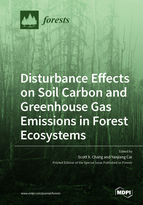Disturbance Effects on Soil Carbon and Greenhouse Gas Emissions in Forest Ecosystems
A special issue of Forests (ISSN 1999-4907). This special issue belongs to the section "Forest Ecophysiology and Biology".
Deadline for manuscript submissions: closed (31 October 2019) | Viewed by 58058
Special Issue Editors
Interests: forest soil processes; forest fertilization and nutrition; carbon sequestration; greenhouse gas emissions; agroforestry
Special Issues, Collections and Topics in MDPI journals
Interests: soil carbon and nitrogen transformations and fluxes; management options towards greenhouse gas mitigation and climate change adaptation
Special Issue Information
Dear Colleagues,
Forest ecosystems are often disturbed by agents such as harvesting, fire, wind, insects and diseases, and acid deposition, with differing intensities and frequencies. Such disturbances can markedly affect the amount, form and stability of soil organic carbon in and the emission of greenhouse gases, including CO2, CH4, and N2O, from forest ecosystems. It is vitally important that we improve our understanding of the impact of different disturbance regimes on forest soil carbon and greenhouse gas emissions to guide our future research, forest management practices, and policy development. Through this special issue, we aim to bring together researchers working on different aspects of forest ecology to share their findings on disturbance effects on soil carbon and greenhouse gas emissions in forest ecosystems. Comparisons on disturbance effects can be made among biomes and climate regions.
Prof. Dr. Scott Chang
Dr. Yanjiang Cai
Guest Editors
Manuscript Submission Information
Manuscripts should be submitted online at www.mdpi.com by registering and logging in to this website. Once you are registered, click here to go to the submission form. Manuscripts can be submitted until the deadline. All submissions that pass pre-check are peer-reviewed. Accepted papers will be published continuously in the journal (as soon as accepted) and will be listed together on the special issue website. Research articles, review articles as well as short communications are invited. For planned papers, a title and short abstract (about 100 words) can be sent to the Editorial Office for announcement on this website.
Submitted manuscripts should not have been published previously, nor be under consideration for publication elsewhere (except conference proceedings papers). All manuscripts are thoroughly refereed through a single-blind peer-review process. A guide for authors and other relevant information for submission of manuscripts is available on the Instructions for Authors page. Forests is an international peer-reviewed open access monthly journal published by MDPI.
Please visit the Instructions for Authors page before submitting a manuscript. The Article Processing Charge (APC) for publication in this open access journal is 2600 CHF (Swiss Francs). Submitted papers should be well formatted and use good English. Authors may use MDPI's English editing service prior to publication or during author revisions.
Keywords
- Carbon stability
- Disturbance intensity
- Frequency
- Greenhouse gas emission
- Microbial linkage
- Soil-pant relationship







